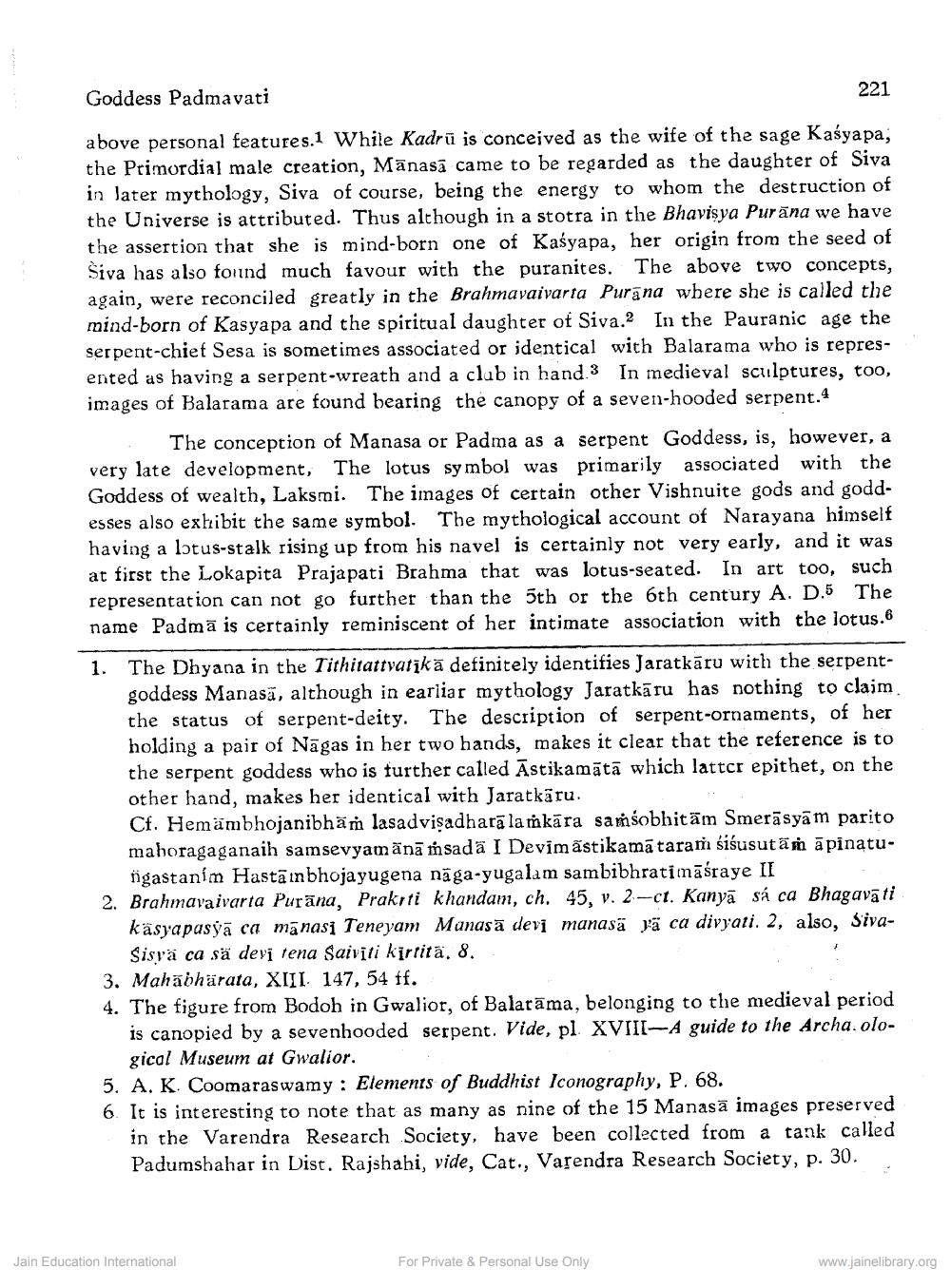________________
Goddess Padmavati
221
above personal features.1 While Kadrü is conceived as the wife of the sage Kaśyapa, the Primordial male creation, Mānasā came to be regarded as the daughter of Siva in later mythology, Siva of course, being the energy to whom the destruction of the Universe is attributed. Thus although in a stotra in the Bhavisya Purana we have the assertion that she is mind-born one of Kaśyapa, her origin from the seed of Siva has also found much favour with the puranites. The above two concepts, again, were reconciled greatly in the Brahmavaivarta Purana where she is called the mind-born of Kasyapa and the spiritual daughter of Siva.2 In the Pauranic age the serpent-chiet Sesa is sometimes associated or identical with Balarama who is represented as having a serpent-wreath and a club in hand 3 In medieval sculptures, too, images of Balarama are found bearing the canopy of a seven-hooded serpent.4
The conception of Manasa or Padma as a serpent Goddess, is, however, a very late development. The lotus symbol was primarily associated with the Goddess of wealth, Laksmi. The images of certain other Vishnuite gods and goddesses also exhibit the same symbol. The mythological account of Narayana himself having a lotus-stalk rising up from his navel is certainly not very early, and it was at first the Lokapita Prajapati Brahma that was lotus-seated. In art too, such representation can not go further than the 5th or the 6th century A. D.5 The name Padmā is certainly reminiscent of her intimate association with the lotus.6
1. The Dhyana in the Tithitattvatīkā definitely identifies Jaratkāru with the serpent
goddess Manasā, although in earliar mythology Jaratkāru has nothing to claim the status of serpent-deity. The description of serpent-ornaments, of her holding a pair of Nāgas in her two hands, makes it clear that the reference is to the serpent goddess who is further called Āstikamātā which latter epithet, on the other hand, makes her identical with Jaratkāru. Cf. Hemämbhojanibhāṁ lasadvisadharā lamkāra saņšobhitäm Smerāsyam parito mahoragaganaih samsevyamānā sada I Devimãstikama taram siśusutām āpinatu
ñigastaním Hastā inbhoja yugena näga-yugalam sambibhratimāśraye II 2. Brahmavaivarta Purāna, Prakrti khandam, ch. 45, v. 2-ct. Kanyā sá ca Bhagavati
käsya pasýā ca manasi Teneyam Manasā devi manasävä сa divyati. 2, also, Siva
Sisyä сa sa devi tena Saiviti kirlitā. 8.. 3. Mahabharata, XIIL 147, 54 tf. 4. The figure from Bodoh in Gwalior, of Balarāma, belonging to the medieval period
is canopied by a sevenhooded serpent. Vide, pl XVIII-A guide to the Archa. olo
gical Museum at Gwalior. 5. A. K. Coomaraswamy : Elements of Buddhist Iconography, P. 68. 6. It is interesting to note that as many as nine of the 15 Manasā images preserved
in the Varendra Research Society, have been collected from a tank called Padumshahar in Dist. Rajshahi, vide, Cat., Varendra Research Society, p. 30.
Jain Education International
For Private & Personal Use Only
www.jainelibrary.org




